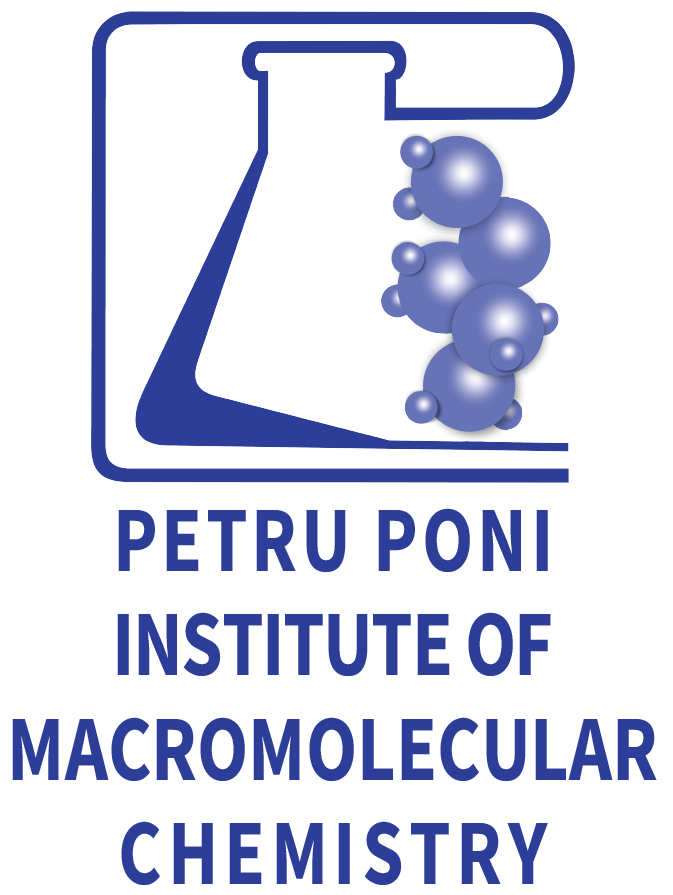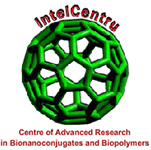| Home | Project Abstract | Objectives | Scientific Reports | Dissemination | News | Contact |
 |
Project results: ![]()
Estimated impact of the 5D-nanoP project, and the most prominent result
The positive impact of the project is expected to cover scientific, industrial, health care and societal fields. From a scientific point of view, the project results are expected to accredit the use of supramolecular dynamic aggregates as key functional components of bioplatforms of different types, including of assembling-line type, in producing therapeutic nanoconstructs according to the principles of nanomedicine.
One of the immediate impacts resulted by using these materials for in vitro characterization of living systems. The already obtained feedback is expected to contribute to the improvement, on the design of the polymer biomedical materials.
The foreseen economic impact derives from the long-awaited knowledge transfer toward clinical and public health applications, and even towards the pharmaceutical industry and market. In this respect, the chemically engineered new carbonic anhydrases inhibitors, silica and conductive polymers (also useful for biointerfacing and bioelectronics) and nanoconjugates are expected to function as high-performance platforms for the effective encapsulation and sustained release of drugs and genes. Moreover, the proposed alternatives for the synthesis of new nanoconjugates could have a less negative impact on the environment.
By approaching compounds containing silicon, the carbon isoster, contributions have been made to expanding the chemical space available for medical chemistry, by creating new options for the development of new delivering, targeting and directly-active systems. The hypervalent silicon functionality should also allow for new approaches to the molecular design of biologically-active nanoconstructs.
The systems for ex vivo testing of nano-medicines are constantly expanding. 5D-nanoP project has developed, tested, and characterized several types of tissue and tumor surrogates with potential applications both in drug development and in tissue engineering.
Advanced achievements results obtained during the progress development of 5D-nanoP project, published in ISI indexed journals (more than 100 ISI papers were published, with an average of more than 6 IF, and some of them with very high IF, for example, Renewable & Sustainable Energy Reviews (IF: 16.799) and Chemical Reviews (IF: 72.087)), were noticed (cited) by the international scientific community working on the emerging fields. As a result, 5D-nanoP project already had an immediate academic impact.
A. Representative results in terms of in silico simulation
1. Vasiliu T., Craciun B.F., Neamtu A., Clima L., Isac D.L., Maier S.S., Pinteala M., Mocci F., Laaksonen A., In silico study of PEI-PEG-squalene-dsDNA polyplex formation: the delicate role of the PEG length in the binding of PEI to DNA, Biomaterials Science 9, 2021, 6623-6640. DOI: 10.1039/d1bm00973g (IF: 7.59)
 Schematic representation of the simulation
protocol of the polyplex formation, for the three studied vectors represented
on the left from top to bottom: PEG500, PEG1500, PEG3000. The first step of the
simulations for PEG aimed at reproducing the aggregation of 30 vector
molecules, while for PEG1500 and PEG3000 a single vector molecule was
equilibrated in water for 10 ns before putting together 30 vector molecules.
Stable aggregates were obtained after 550-900 ns of MD simulation, depending on
the size of the vector. 3 DNA molecules were added to the equilibrated vector,
and MD simulations of in the μs timescale were performed.
Schematic representation of the simulation
protocol of the polyplex formation, for the three studied vectors represented
on the left from top to bottom: PEG500, PEG1500, PEG3000. The first step of the
simulations for PEG aimed at reproducing the aggregation of 30 vector
molecules, while for PEG1500 and PEG3000 a single vector molecule was
equilibrated in water for 10 ns before putting together 30 vector molecules.
Stable aggregates were obtained after 550-900 ns of MD simulation, depending on
the size of the vector. 3 DNA molecules were added to the equilibrated vector,
and MD simulations of in the μs timescale were performed.
Our simulations demonstrate that equilibrating the vector solution, with several hundreds of ns long MD, prior to adding the DNA leads to the formation of a large network of interactions between the vector components, which are largely kept also after the addition of DNA and thus have an important role in its binding. The employed two-step simulation approach mimics the experimental procedure and gives a better understanding of all the mechanisms having a role in DNA binding. All the simulations were found in agreement with the experimental measurements, with the final aggregates of the vectors obtained in the simulation explaining the zeta potential results, and the trends observed in DNA binding matched the trends obtained in the gel electrophoresis experiment. These findings have important implications for the rational design of non-viral genetic vectors, revealing, at the molecular level, how the molecular mass of the widely used stealth agent, PEG, affects the nucleic acid binding to the cationic polymers.
2. Zhang Z., Vasiliu T., Li F., Laaksonen A., Zhang X., Mocci F., Ji X., Novel artificial ionic cofactors for efficient electro-enzymatic conversion of CO2 to formic acid, Journal of CO2 Utilization 60, 2022, 101978 (IF: 8.321)
|
|
Electroenzymatic conversion of CO2 to formic acid, and chemical structures of the studied bipyridinium-based redox cofactors. |
In this study, six artificial cofactors were designed and synthesized for the enzymatic CO2 reduction to formic acid. All the bipyridinium-based artificial cofactors presented a superior catalytic performance compared to the natural cofactor NADH, owing to the suppression of the reverse oxidation reaction. Specifically, the formic acid concentration by using the cofactor BPNC2 is 47 times higher than that of NADH. MD simulations give further molecular insight into the behavior of the cofactor, confirming BPNC2 with the highest affinity of CO2, which is consistent with the experimental observations. Last, ab initio calculations indicate that the functional groups R also affect the electronic distribution and the electron-donating capability of BP core, and interestingly the positively charged functional groups as NC2 and NC3 can surprisingly lead to an increased electron-donating capability of the heavy atoms belonging to the aromatic core, as revealed by the condensed Fukui f- functions. The different catalytic activity of the artificial cofactors is therefore due to a combination of several contributions, comprising the affinity for CO2, the effect on the electron-donating capability in the BP rings and also the reactivity of the functional group itself. Our analysis should pave the way for future systematic studies aimed at disentangling the relative weight of each contribution to find a quantitative structure-activity relationship.
3. Vasiliu T., Mocci F., Laaksonen A., De Villiers Engelbrecht L., Perepelytsya S., Caging polycations: Effect of increasing confinement on the modes of interaction of spermidine3+ with DNA double helices, Frontiers in Chemistry 10, 2022, 836994. DOI: 10.3389/fchem.2022.836994 (IF: 5.545)


|
(Left) (a) Schematic representation of the simulation box for systems DD-20Å, DD-25Å, DD-30Å, together with the numbering of the nucleotide bases, and the indication of the positioning of the restraints used in the simulation to maintain the initial relative orientation and distance between the DNA helices. (b) T-A and C-G base pairs with the label of the atoms used as reference in the analysis. (c). Schematic representation of the structure of the solvent and counter- and co-ions of DNA. The force fields used to describe the components are also indicated. (Right) Simulated system of nucleosomal DNA. (a) Nucleosomal DNA: red and blue colors indicate the overlapping parts of the DNA double helix, non-overlapping DNA colored grey. (b) Schematic structure of the nucleosomal DNA in the simulation box. The numbering of the nucleotide pairs is indicated. |
Four model systems, each containing two DNA double helices with different DNA-DNA distances, in the presence of Spd3+ and KCl, have been studied using MD computer simulations, with the aim to understand how the separation between DNA double helices influences the interaction with PAs. Also, the dynamics of the Spd3+ molecules are strongly affected by the DNA-DNA separation: at a very short distance (20 Å) the Spd3+ located between the DNA molecules are effectively stuck in their binding sites; increasing the inter-helical separation to 25 Å, the PAs still maintain relatively long residence times in the region between the helices, but they move from one binding site to another. Further increasing the separation between the DNA helices to 30 Å leads to a further increase in Spd3+ mobility, thus reducing the residence time in the inter-helical space.
B. Representative results in terms of synthesis, physical-chemical characterization and biological properties evaluation of the constituents of dynamic assembling supramolecular nanoplatforms
(1) Angeli A., Pinteala M., Maier S.S., Simionescu B.C., Milaneschi A., Abbas G., del Prete S., Capasso C., Capperucci A., Tanini D., Carta F., Supuran, C.T., Evaluation of thio- and seleno-acetamides bearing benzenesulfonamide as inhibitor of carbonic anhydrases from different pathogenic bacteria, International Journal of Molecular Science 21 (2), 2020, 598. DOI: 10.3390/ijms21020598 (IF: 6.208); (2) Angeli A., Pinteala M., Maier S.S., del Prete S., Capasso C., Simionescu B.C., Supuran C.T., Inhibition of α-, β-, γ-, δ-, Ɛ- and η- class carbonic anhydrases from bacteria, fungi, algae, diatoms and protozoans with famotidine, Journal of Enzyme Inhibition and Medicinal Chemistry 34, 2019, 644-650. DOI: doi:10.1080/14756366.2019.1571273 (IF: 5.756); (3) Angeli A., Pinteala M., Maier S. S., Toti A., Di Cesare Mannelli L., Ghelardini C., Seleri S, Carta F. Supuran, C.T., Tellurides bearing benzensulfonamide as carbonic anhydrase inhibitors with potent antitumor activity, Bioorganic & Medicinal Chemistry Letters 45, 2021, 128147. DOI: 10.1016/j.bmcl.2021.128147 (IF: 2.94); (4) Clima L., Craciun B.F., Angeli A., Petreni A., Bonardi A., Nocentini A., Carta F., Gratteri P., Pinteala M., Supuran C.T., Synthesis, computational studies and assessment of in vitro activity of squalene derivatives as Carbonic Anhydrase inhibitors, ChemMedChem 15, 2020, 2052-2057. DOI: 10.1002/cmdc.202000500 (IF: 3.54)
Members of a CAIs (inhibitors of carbonic anhydrases) library of selenazole, famotidine, tellurides, sulfur and selenium-containing type were synthetized and tested as potential antimicrobials able to fight against multidrug resistance towards classical antibiotics. Some of them were translated at the nanometer scale. In this idea, CAIs-squalene derivatives can act as self-assembling unimmer, demonstrating to be 3-4 times more effective at blocking carbonic anhydrase than necked CAIs.
(6) Molina B.G., Cianga L., Bendrea A.-D., Cianga I., Aleman C., Armelin E., An amphiphilic, heterografted polythiophene copolymer containing biocompatible /biodegradable side chains for use as (electro) active surface in biomedical applications, Polymer Chemistry 10, 2019, 5010-5022; DOI:10.1039/C9PY00926D (IF: 5.364); (7) Molina B.G., Bendrea A.D., Lanzalaco S., Franco L., Cianga L., del Valle L.J., Puiggali J., Turon P., Armelin E., Cianga I., Aleman C., Smart design for a flexible, functionalized and electroresponsive hybrid platform based on poly(3,4-ethylenedioxythiophene) derivatives to improve cell viability. Journal of Materials Chemistry B 8, 2020, 8864-8877. DOI: 10.1039/d0tb01259a (IF: 7.571); (8) Bendrea A.-D., Cianga L., Ailiesei G.-L., Cianga I., Fluorescent EDOT-functionalized Poly-ε-caprolactone: Synthesis, photophysical and self-assembling properties in organic solvents and its serendipitously noticed behaviour in protonated media, Proceedings, vol 69 (1), 2021, 13-14. https://www.mdpi.com/2504-3900/69/1/13; (9) Bendrea A.D., Cianga L, Ailiesei G.L., Ursu E.L, Goen Colak D., Cianga I., 3,4-Ethylenedioxythiophene (EDOT) End-group functionalized Poly-ε-caprolactone (PCL): Self-assembly in organic solvents and its coincidentally observed peculiar behavior in thin film and protonated media, Polymers 13, 2021, 2720. DOI: 10.3390/polym13162720 (IF: 4.967); (10) Bendrea A.-D., Cianga L., Cianga I., Thiophene end-group functionalized oligo(2-methyl-2-oxazoline) as an amphilphilic reactive macromonomer and as a non-conventional intrinsic luminescent material, Proceedings of International Conference, Progress in Organic and Macromoleculecular Compounds, pp. 83-84 (2021), ISSN 2810-2347; (11) Bendrea A.-D., Cianga L., Ailiesei G.L., Goen-Colak D., Popescu I., Cianga I., Thiophene α-chain-end - functionalized oligo(2-methyl-2-oxazoline) as precursor amphiphilic macromonomer for grafted conjugated oligomers / Polymers and as a multifunctional material with relevant properties for biomedical applications, International Journal of Molecular Sciences, Accepted 30 of June 2022 (IF: 6.208)
A new 3D all-polymer electroactive, flexible interface, constructed in a hierarchical manner, using as a support a film of isotactic polypropylene and as a coating layer a "molecular composite" based on poly(3,4-ethylenedioxythiophene) (PEDOT) backbone and randomly distributed short PCL side chains (PEDOT-g-PCL) was reported by I. Cianga & C. Aleman et all in J. Mater. Chem. B, 2020, 8, 8864. The constructed system has an optimized tissue integration performance with potential applications in bioimplants for tissue regeneration or as soft implantable bioelectronics.
By intelligently combining the components of well-known polymeric biomaterials (PEG and PCL) with a multi-sensitive conjugated polymer (PTh), a biomimetic material was reported by I. Cianga & C. Aleman et all in Polym. Chem., 2019, 10, 5010-5022. This new material, showing high performances in biomimetic aqueous electrolytes, was used for NADH coenzyme biosensor construction, with a potential impact in the prevention and early diagnosis of neurodegenerative diseases.
|
|
|
|
3D all-polymer electroactive, flexible and biocompatible 3D nanoplatform |
(Electro) bioactive material used for NADH biosensing |
(12) Turtoi M., Anghelache M., Bucatariu S.M., Deleanu M., Voicu G., Safciuc F., Manduteanu I., Fundueanu G., Simionescu M., Calin M., A novel platform for drug testing: Biomimetic three-dimensional hyaluronic acid-based scaffold seeded with human hepatocarcinoma cells, International Journal of Biological Macromolecules 185, 2021, 604-619. DOI: 10.1016/j.ijbiomac.2021.06.174 (IF: 8.025).
A novel hyaluronic acid (HA)-based 3D cell model (HA3P50) suitable for chemotherapeutic drug testing on hepatocellular carcinoma was developed. Compared to 2D, the cells grown in the HA3P50 scaffold proliferate into larger-cellular aggregates that exhibit liver-like functions. Also, growing the cells in the scaffold sensitize the hepatocytes to the anti-tumor effect of cisplatin, by a mechanism involving the activation of ERK/p38α-MAPK and dysregulation of NF-kB/STAT3/Bcl-2 pathways. Moreover, the system can be adapted and employed as experimental platform functioning as a proper tissue/tumor surrogate.
(13) Bucatariu S.M., Constantin M., Varganici C.D., Rusu D., Nicolescu A., Prisacaru I., Carnuta M., Anghelache M., Calin M., Ascenzi P., Fundueanu G., A new sponge-type hydrogel based on hyaluronic acid and poly(methylvinylether-alt-maleic acid) as a 3D platform for tumor cell growth, International Journal of Biological Macromolecules 165 (B), 2020, 2528-2540. DOI: 10.1016/j.ijbiomac.2020.10.095 (IF: 8.025)
|
|
Cisplatin-induced cytotoxicity in HepG2 cells cultured on 2D support and in HA3P50 scaffold (3D). HepG2 cells grown on 2D and in 3D systems for 7 days were exposed for 24 hours to 5-100 µM cisplatin or 0.1% DMSO (control cells). (A) The cisplatin cytotoxicity in HepG2 cells was investigated by the release of the adenylate kinase in the culture medium. (B) Live (green)/dead (red) assay of control cells and 25 μM cisplatin-treated HepG2 cells. Scale bar: 200 μm. (C) The percentage of dead/total cell number obtained by live/dead cell assay. (D) 3D reconstruction images of the Z-stacking sections for live/dead assay of control and cisplatin-treated HepG2 cells grown in HA3 P50 scaffold. The results were shown as mean ± SD and analyzed using unpaired two-tailed Student's t-test: * p < 0.05, **p < 0.01, ***p < 0.001 and # p < 0.05. |
HepG2 cells cultured for 21 days in the surrogate proliferate to large cellular aggregates and gain liverlike functions such as the improved release of albumin, urea, bile acids, and transaminases, and the enhanced synthesis of CYP7A1. After 7 days, HepG2 cells cultured in scaffold exhibit enhanced chemosensitivity to cisplatin (increased cytotoxicity and DNA fragmentation and rearrangement of the cytoskeleton). The scaffold is hydrolyzed by the enzymatic action of hyaluronidase and is highly absorptive for doxorubicin. The data suggest that the HA/PMVEaltMA) scaffold can be used as an HA-based 3D cell platform for testing the effect of chemotherapeutic drugs on hepatocellular carcinoma. Also, the newly developed HA-based 3D model can be adapted and employed as an experimental platform for drug testing in other pathologies.
|
|
Schematic representation of the synthesis steps of surrogate hydrogel based on hyaluronic acid (HA) and poly(methylvinylether-alt-maleic acid) (P(MVEaltMA)) cross-linked by solvent free thermal method. |
(14) Constantin M., Bucatariu S., Popescu I., Cosman B., Ascenzi P., Fundueanu G., Intelligent micro-vehicles for drug transport and controlled release to cancer cells, Reactive and Functional Polymers 165, 2021, 104961. DOI: 10.1016/j.reactfunctpolym.2021.104961 (IF: 4.966)
|
|
Schematic representation of the poly(N-isopropylacrylamide-co-4-vinylpyridine)-based nano-platforms behaviour after i.v. administration. |
Nano-platforms are stable in the blood, accumulate at sites with increased vascular permeability (tumors), where they are internalized by the cancer cells by macropinocytosis, considering their size. In the early and late endosomes (pH: 6.0 ‒5.5), they are stable but start to disintegrate and release the drug cargo in the lysosomes (pH = 5.0).
(15) Fundueanu G., Constantin M., Turtoi M., Bucatariu S., Cosman B., Anghelache M., Voicu G., Calin M., Bio-responsive carriers for controlled delivery of doxorubicin to cancer cells, Pharmaceutics 14, 2022, 865. DOI: 10.3390/pharmaceutics14040865 (IF: 6.525).
The bio-responsive poly(N-isopropylacrylamide-co-vinylimidazole) copolymer was synthesized and characterized. The poly(NIPAAm-co-VI)-based nanoparticles are biocompatible and may be introduced as carriers for the antitumoral drug, doxorubicin. The nanoparticles (NS-DXR) might have the potential to deliver DXR to hepatic tumors and, besides, the particulate system can be adapted and endowed with targeting properties by conjugating specific ligands to direct them more efficiently to a certain tumor.
|
|
(A) Localization of NS-DXR and free DXR in organs harvested from C57BL/6 mice. The analysis was completed 1 h after the retro-orbital injection of NS-DXR, free DXR, or PBS in mice using the imaging system IVIS Caliper 200, by detection of the DXR fluorescence using the filter set λex/λem: 500 nm/600 nm. (B) Quantification of total radiant efficiency in organs using the region-of-interest option of Living Image software. (C) Spectral unmixing analysis to delineate the signal specific for DXR fluorescence (red) and tissue autofluorescence (green). (D) Quantification of DXR in plasma and urine of mice, 1 h after administration of 3 mg/kg of free DXR or incorporated into NS-DXR, at λex = 480 nm and λem = 590 nm. * p < 0.05, *** p < 0.001. (E) Evaluation of in vivo hemocompatibility by following the erythrocyte aggregation after the administration of NS-DXR and free DXR. Samples from mice who received PBS were considered the negative control. Scale bar: 50 μm. |
(16) Racles C., Zaltariov M.F., Peptanariu D., Vasiliu T., Cazacu M., Functionalized mesoporous silica as doxorubicin carriers and cytotoxicity boosters, Nanomaterials 12(11), 2022, 1823, 1-26. DOI: 10.3390/nano12111823 (IF: 5.719)
Mesoporous silica functionalized with thiol groups and, for the first time, its derivative post-modified with glucoside moieties by green thiol-ene photoaddition were prepared and used as carriers for Dox. The physical interactions responsible for the Dox encapsulation were investigated by analytic methods and MD simulations, and were correlated with the high loading efficiency of organo-modified MSNs. The in vitro cytotoxicity was evaluated on NDHF, MeWo and HeLa cell lines by CellTiter-Glo assay, revealing strong cytotoxic effects in all of the loaded silica at low equivalent Dox concentration and selectivity for cancer cells.
(17) Zaltariov M.F., Turtoi M., Peptanariu D., Macsim A.M., Clima L., Cojocaru C., Vornicu N., Ciubotaru B.I., Bargan A., Calin M., Cazacu M., 3 Organosilatrane hanging 5-nitrosalicylaldimine motif: Synthesis, full structural characterization and a multi-tool approach to assessing its medicinal significance, European Journal of Medicinal Chemistry, Under review, 2022 (IF: 7.088)
1-(3-{[(2-Hydroxy-5-nitrophenyl)methylidene]amino}propyl)silatrane, containing two chemical motifs, of interest for medicinal chemistry, silatrane and nitro group, attached in position 5 to salicylaldehyde, coupled in a new structure, through an azomethine moiety, also known as a versatile pharmacophore was isolated for the first time and fully characterized. The cytotoxicity studies on two cancer cell lines (HepG2 and MCF-7), and protein binding ability - with major role in drug ADME, revealed a higher cytotoxic activity on HepG2 and MCF-7 cell lines with higher selectivity on MCF7 cell lines.
| Designed & Maintained by CLICK NET SOLUTIONS |












